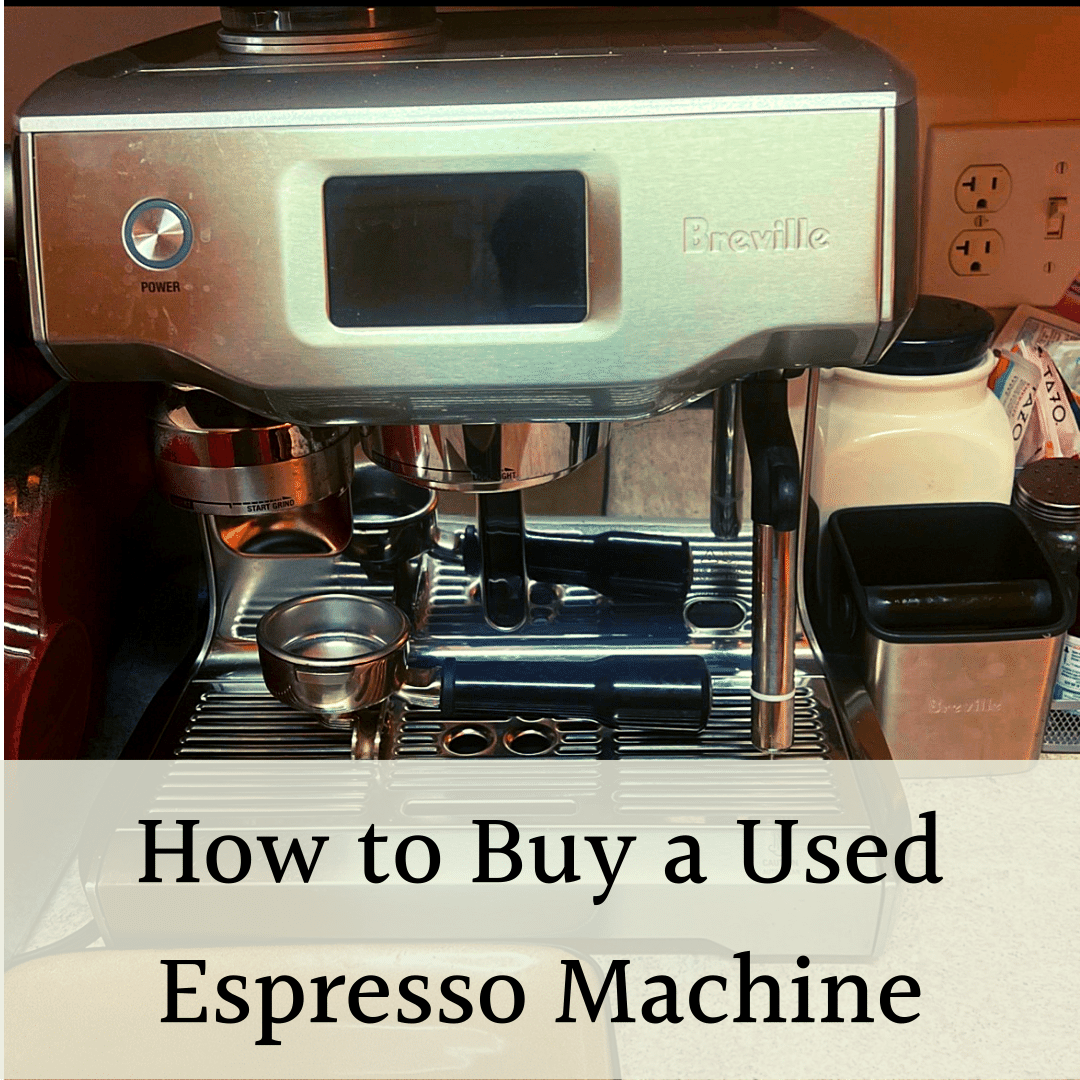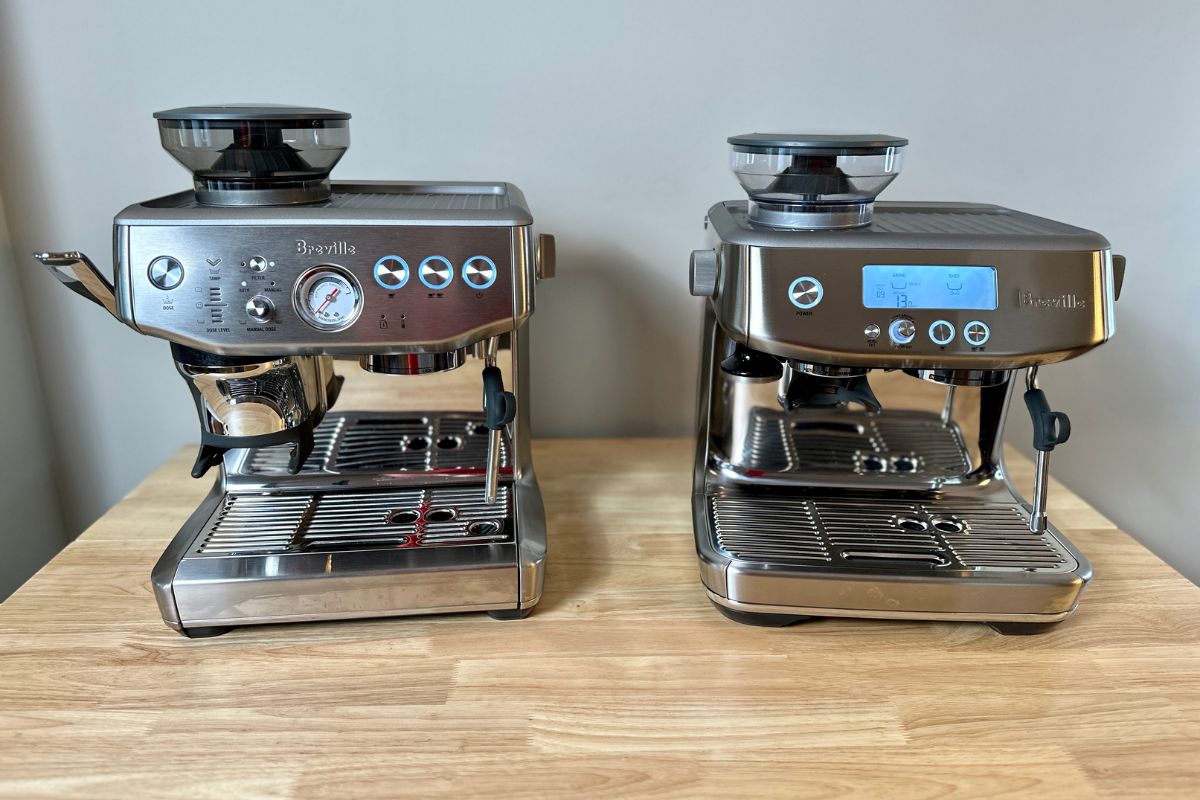
Breville’s lineup of “Barista” espresso machines are extremely popular, and we’ve long liked the Barista Pro at Craft Coffee Spot. However, Breville recently updated the Express line with the “Impress” model, which adds assisted tamping. Is this the new standard?
I tested both models, and it’s a close call. The Breville Barista Express Impress is great if you want ease of use, and the intuitive tamping system makes it our new favorite for absolute beginners. However, I stick with the Barista Pro overall because it has more options and a better steam wand. The Pro is the better model if you’ll be in espresso for the long haul.
Let’s delve into the nuanced comparison of the Breville Barista Express Impress vs. Barista Pro. I’ll uncover the little details that can make all the difference in your daily coffee ritual.
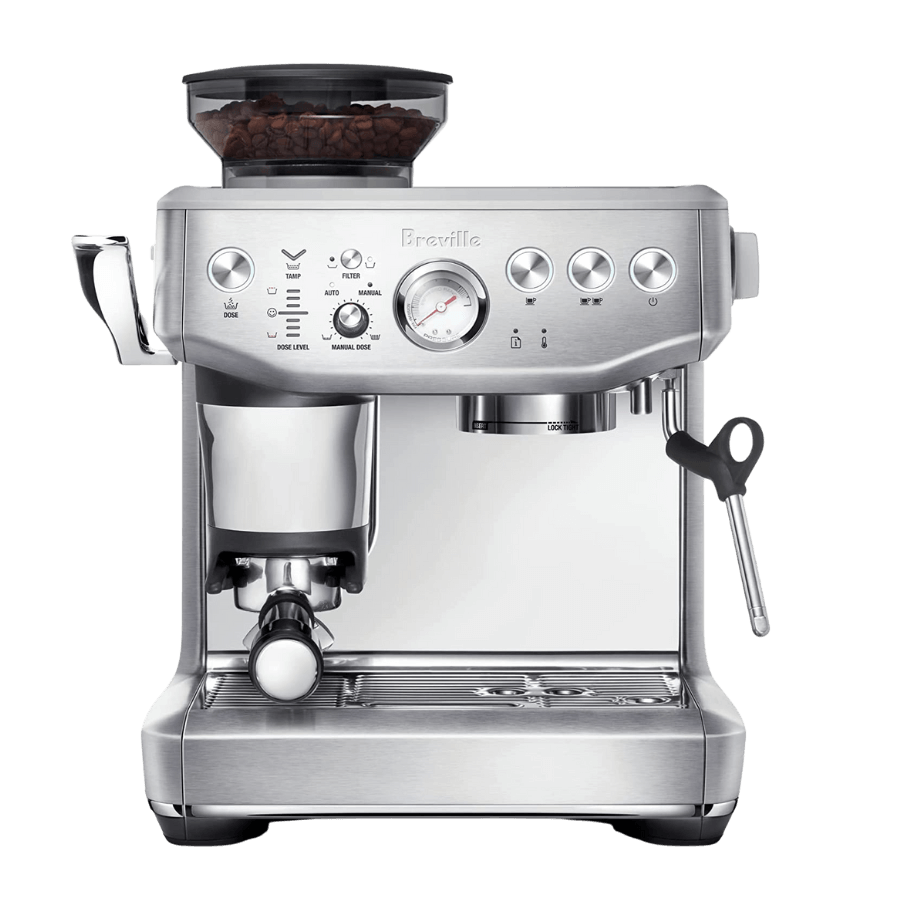
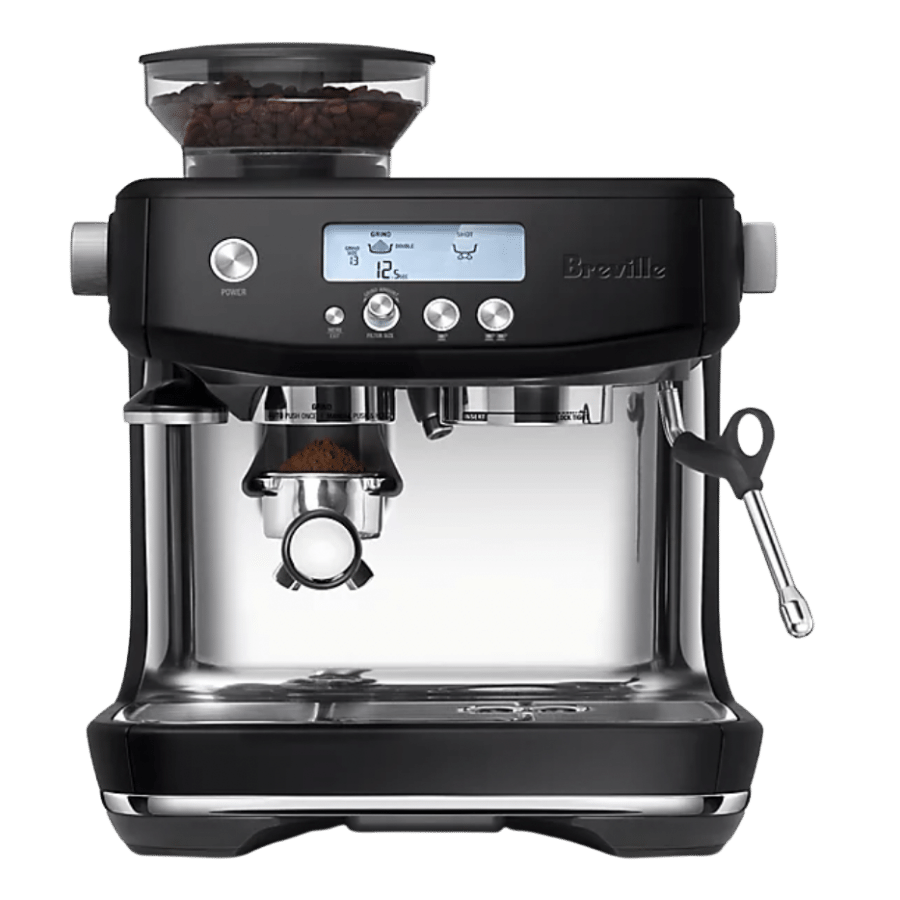
Feature Comparison (Similarities and Differences)
Here’s exactly how similar and different these two home espresso machines are, including which one is better value.
Design and Build
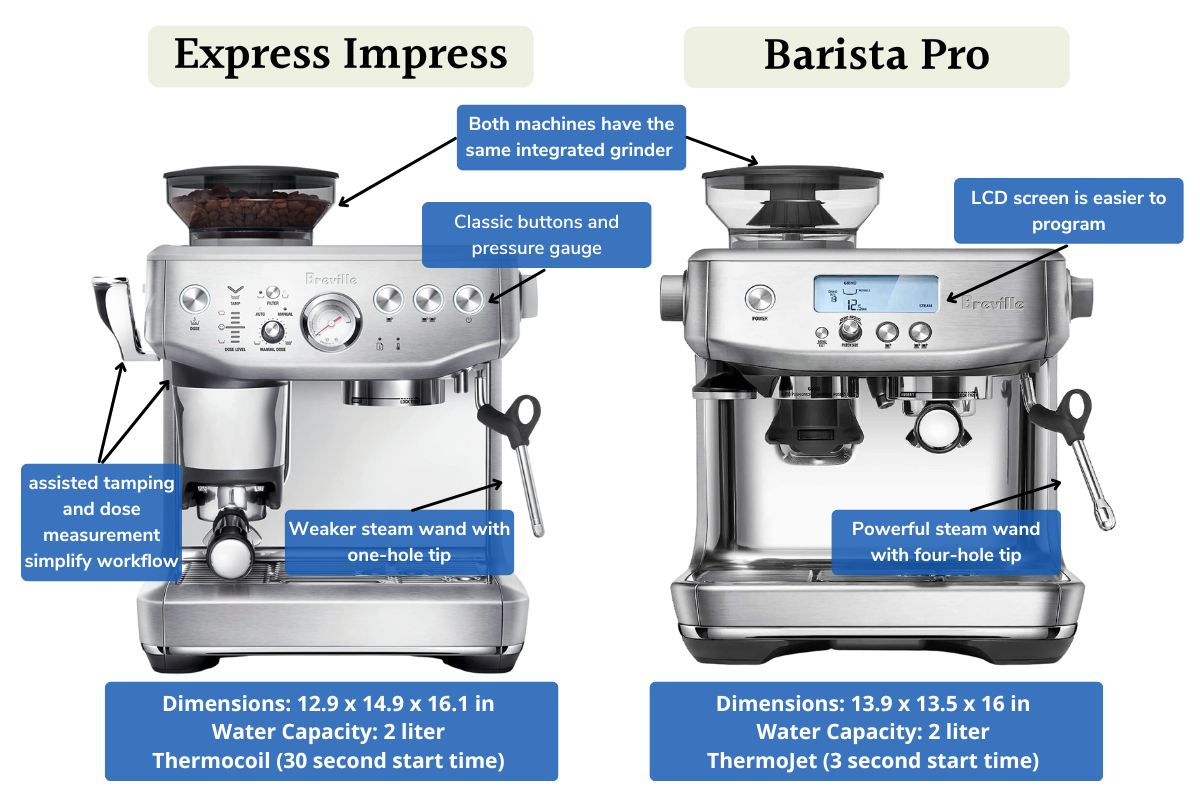
Breville Barista Express Impress and Barista Pro have similar designs and build. They’re medium-sized machines, with the Express Impress dimensions 12.9″ x 14.9″ x 16.1″ and the Pro 13.9″ x 13.5″ x 16″ (WxDxH). The Express Impress is slightly narrower, but both will fit under your kitchen cabinets. Also, both have built-in grinders, which means no extra space is needed.
Both machines have rounded edges and a recognizable Breville stainless steel design. The Barista Pro comes in nine color options, while the Express Impress is only available in stainless steel.
The main design difference is the LCD display on the Breville Barista Pro. You can see information such as the grind size, grinding time, temperature, and a brewing timer on the Pro’s display. The display also makes it incredibly easy to program the espresso machine.
Meanwhile, the Breville Barista Express Impress has buttons and an analog pressure gauge. The Express Impress is an upgraded version of the famous Breville Barista Express. Overall, even though the Barista Pro is the older model, it feels more modern than the Express Impress.

The biggest design difference is the tamping arm on the left, which I’ll explain.
Express Impress Self-Tamping
One major difference between the Express Impress and the Pro is the auto-tamping lever on the Express Impress.
Assisted tamping and auto dosing means the Express Impress calculates the optimal dose of coffee beans and automatically tamps your puck.

You insert the portafilter, press dose, and the machine grinds into the portafilter. Then you tamp down and the lever arm applies 22 pounds of force (just enough and not too much).
After you tamp, a series of lights indicate whether the portafilter was properly filled. In case it’s not, the machine adjusts automatically next time. Meanwhile, it’s impossible to get an unlevel tamp. Tamping espresso is an important part of puck prep and is easy to mess up. The Impress tamper is always perfectly level and gives a good amount of force without overdoing it. Best of all, there’s no mess when you pull out the portafilter.
On the Barista Pro, you can dose right into your portafilter. But you need to level out the mound of coffee grounds and use the Breville tamper to compress the puck. We recommend espresso accessories that simplify tamping, but it’s more work than the Impress. However, the advantage of the Pro is you have more control over the puck, which can definitively improve espresso.
Overall, the tamping process is much easier on the Impress and streamlines the brewing process.
Espresso Brewing
The heating system is different, which is the biggest difference between these two models.
The Barista Pro has a newer ThermoJet heating system, which heats water in an impressive three seconds. The water has an optimal espresso brewing temperature of 200 degrees F (93 C).
Meanwhile, the Breville Barista Express Impress uses an older thermocoil, which needs 30 seconds to heat up. When testing the old Barista Expres vs Pro, I found the newer ThermoJet was consistently better in temperature stability and led to consistently better flavor on the Pro.

I was initially skeptical of the Express Impress because of this older heating system. When we tested the legacy Barista Express vs Pro, the thermocoil had more temperature variation than the TheermoJet. The inconsistent temperature on the thermocoil led to a “sharper” taste with alternating unpleasant bitterness and sourness.
However, the espresso flavor is very similar on both the Barista Pro and the Express Impress. That’s because the Express Impress uses lower pressure.
Think of it this way – you need high pressure to extract finely ground coffee for espresso. But if the pressure is too high, the water flies through the coffee without full extraction. Super high pressure creates channels in the puck and you don’t get a full taste.
Also, Breville espresso machines are notorious for high pressure. They often run at 12 to 13 bars, well above the nine bar standard for most espresso machines.
This is why espresso often sprays everywhere when you use a bottomless portafilter. However, this doesn’t happen on the Express Impress.

I tested pressure by using the same grinder (DF64), same grind size, same dose, and even tamped each shot with the Express Impress system. Literally, every input was the same, yet the shot ran 11 seconds faster on the Barista Pro. The implied flow rate was 50% higher on the Barista Pro.
| Coffee in | Espresso Out | Time | Flow Rate | |
|---|---|---|---|---|
| Barista Express Impress | 18g | 37.5 | 35.8 seconds | 1.05 g/s |
| Barista Pro | 18g | 36.5 | 24 seconds | 1.52 g/s |
Essentially, lower pressure compensates for the weaker temperature stability on the Express Impress. Espresso tastes about the same as the Barista Pro, and both are excellent.

Also, both machines have the PID, which ensures precise temperature control and water pressure. The low-pressure pre-infusion wets the coffee beans at lower pressure, which lets the coffee bloom on both machines. This reduces channeling and helps you have even extraction and more flavorful espresso.
I walk through just how different the shots are on our video review:
However, you can’t do “advanced distribution” like using a WDT tool on the Breville Barista Express Impress. Distribution is a very important part of the puck preparation, and it can’t be done on the Impress because of the automatic tamping and dosing (you can’t remove the portafilter from the brew head before tamping).
When I use a WDT on the Barista Pro, the espresso handily beats the Barista Express Impress. That said, you might notice if you’re an espresso-brewing newbie (and don’t care what “WDT” means). But, if you want to perfect your espresso skills, this will be a downside to the Impress.
Grinder and the Number of Grind Settings
Both Breville Barista Pro and Express Impress have integrated burr grinders. The Pro has 30 settings, while the Express Impress has 25. Overall, more settings are better, as it means a better chance of dialing in the espresso shot for perfect flow. That being said, the difference in grind settings is minor, and you can dial in well on both espresso machines.
Overall, apart from a few more settings, the grinders are the same on these espresso machines. The conical burr is the exact same on both models.
The bigger difference is you can automatically tamp on the Barista Impress model, as discussed earlier.
Still, the Barista Pro espresso machine is easy to use. Place the portafilter under the grinder, tap it in, and you’ll get a preset amount of coffee grounds.
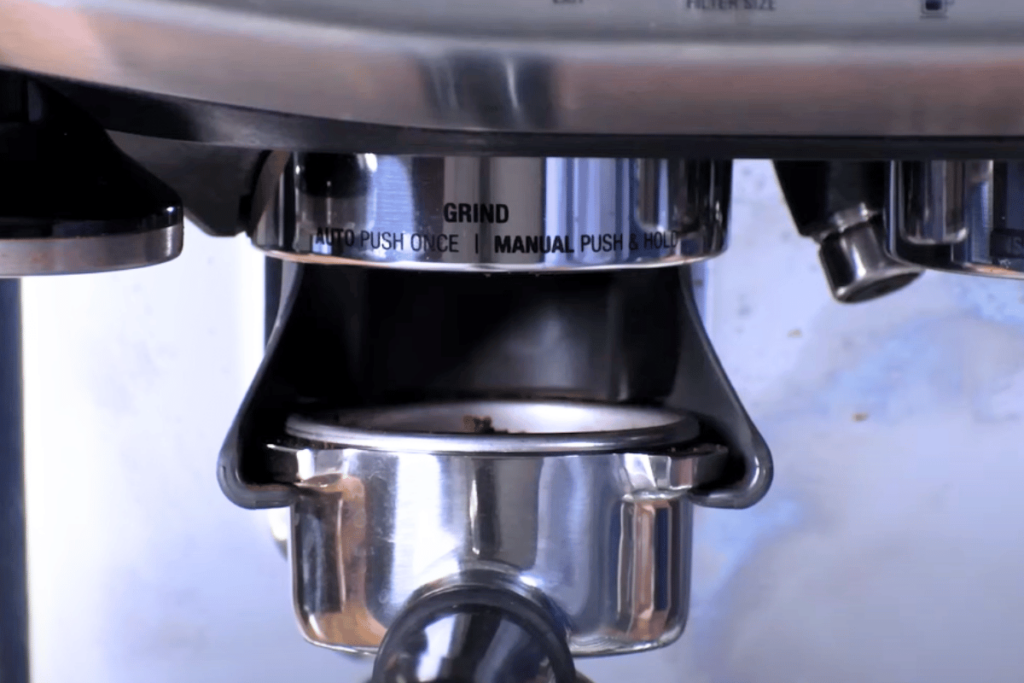
You can change the grind time on the LCD screen. There is no tamper, but it is easier than weighing, grinding, and transferring to the brew head. You can also pause in the middle of grinding with the “grind pause” function. That helps to quickly shake the portafilter and even out the grounds.
Milk Frothing
Milk frothing is an area where the Barista Pro clearly beats the Express Impress. The steam wand on the Breville Barista Express Impress remained the same as on the Barista Express — a one-hole steam wand.
I mentioned Barista Pro has a ThermoJet system, which improves the milk steaming process. This espresso machine has a four-hole steam wand, which allows steam output compared to the single hole on the Express Impress.
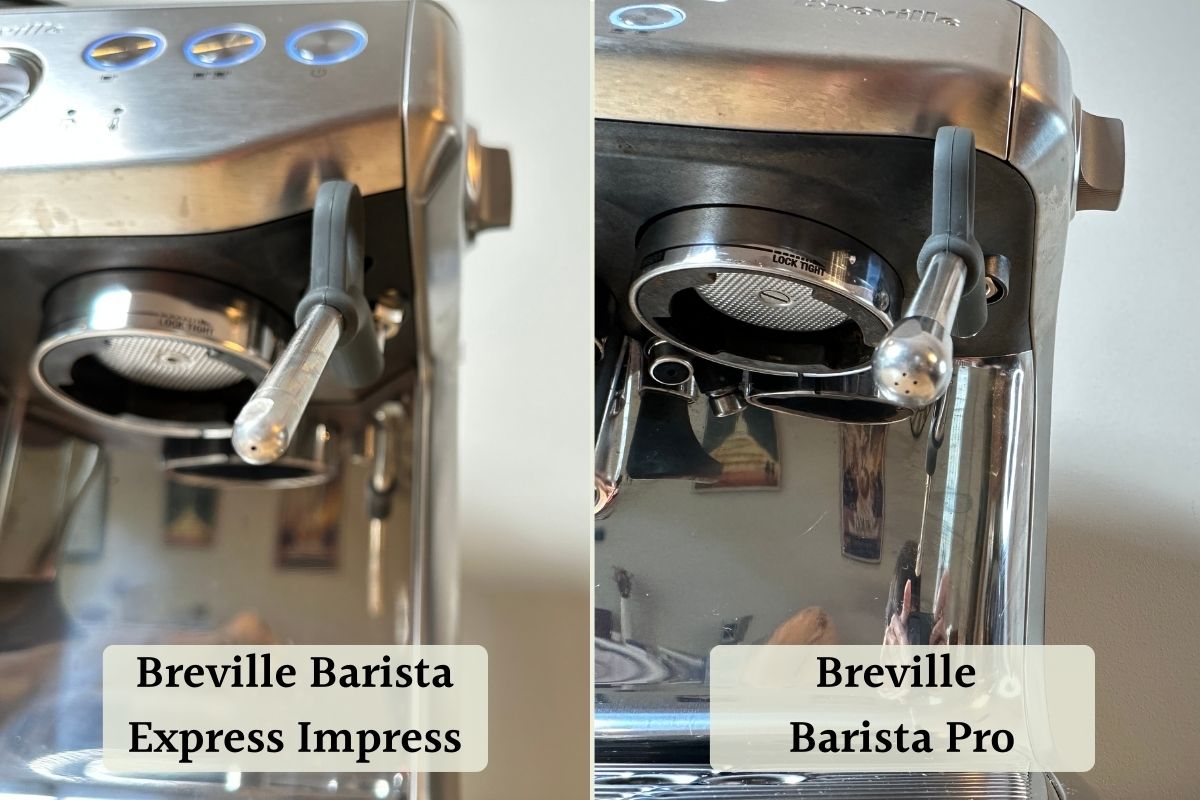
The four holes on the Breville Barista Pro aerate milk faster and make better microfoam for latte art.
Also, the ThermoJet is simply more powerful on the Barista Pro, and the steam wand starts within seconds. Meanwhile, you have to let the Impress steam wand run for 30 seconds before it gets up to full pressure.

Also, the thermocoil has low pressure on the Impress, and it’s hard to create microfoam. Milk frothing takes 80 to 90 seconds on the Impress, compared to 45 to 50 seconds on the Barista Pro.
Higher pressure really lets you inject air to steam milk on an espresso machine properly. Also, the Express Impress spits out a lot of water, diluting your milk and producing a flat taste in lattes.
Note: I even switched holes on the steam wands and still had better results on the Barista Pro espresso machine. This means the ThermoJet heating system creates better steaming results.
Programming and Additional Features
The Breville Barista Pro espresso machine has more programmable features. You can change the brew time, grind time, grind size, water temperature, and pre-infusion time. Essentially, you can change every aspect of the espresso brewing.
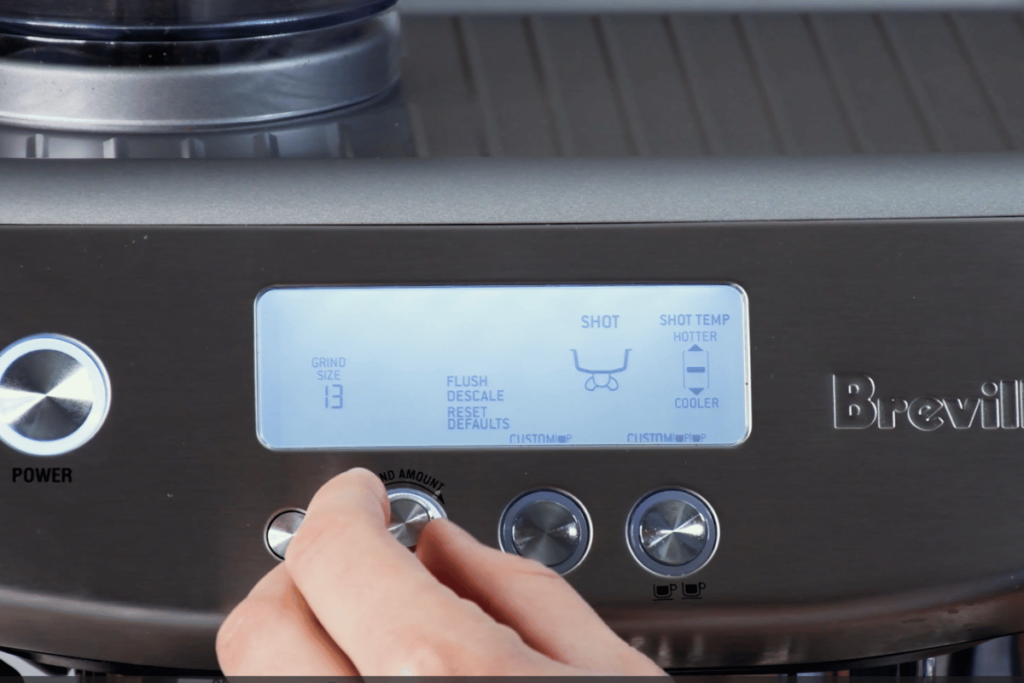
On the Breville Barista Express Impress, you can change the shot volume and water temperature, but the pre-infusion can’t be reprogrammed (you can change it with a manual shot). I like being able to change the pre-infusion, as longer pre-infusion reduces channeling, which is a great hack, especially if you’re a new barista.
Also, it’s easier to change these settings on the Breville Barista Pro, thanks to the LCD display. On the other hand, the Breville Barista Express Impress has buttons. I always have to check the manual to change the water temperature and program shot volume.
Overall, the Barista Pro has a few more programmable features, making changes easier.
Another issue is that the drip tray fills very quickly on the Express Impress espresso machine compared to the Pro. This happens because the thermocoil heating system discharges more water to maintain temperature stability.
There are two last annoyances to mention on the Impress:
- The hot water spout is located off the brew head, and it’s hard to access next to the steam wand. The spout is angled on the Barista Pro, so the water goes right into the cup when making an Americano.
- There’s no low water sensor on the Impress water tank, and I’ve had the excruciating experience of running out of water mid-shot.
Value
Both of these Breville machines provide good value for money. They have a premium design and all the features to make delicious coffee.
They are priced almost identically as this writing, with the Barista Pro costing a little less. Considering this, my vote for the best value goes to the Breville Barista Pro. It has a more advanced heating system, a more powerful steam wand, and more programmable options at almost the same price as the Breville Barista Express Impress.
Note these prices have changed a lot in the last year, so you can check your local product listing.
Recommendation: Is Breville Barista Express Impress or Breville Barista Pro Better?
At the risk of repeating myself, both of these espresso machines are good choices. Here’s the distinction:
Breville Barista Express Impress has a simpler workflow and is a better option if you don’t want to learn how to make pucks and tinker with adjusting the brewing parameters. It’s our favorite espresso machine for beginners.
Overall, choose the Express Impress if you want to avoid the most complex parts of pulling a shot but don’t want a completely super-automatic espresso machine.

Breville Barista Express Impress highlights:
- Thermocoil: 30-second heat up
- One-hole steam wand (less powerful)
- Assisted dose and tamping make puck pre much easier.
Choose Breville Barista Pro if you want to maximize your barista skills. It’s also a great choice if you want an espresso machine that you can develop into.
Where the Express Impress is geared toward espresso newbies, the Barista Pro can be used by professionals due to its ability to program every part of the espresso shot. Finally, has it comes in more stylish colors.

Breville Barista Pro highlights:
- Thermojet: 3-second heat up
- Four-hole wand (creates better quality microform)
- Manual tamping and puck preparation
Breville Barista Pro vs. Express Impress: Final Thoughts
You won’t make a mistake with either of these espresso machines. The question is how much work you want to put in and how much programmability you want. Get the Express Impress espresso machine if you want ease of use. Get the Barista Pro Breville espresso machine if you want more control over the espresso quality and superior steaming performance.
These may be two of the most popular Breville espresso machines, but Breville offers many more options. We’ve used and tested most of the Breville lineup and created a round-up of the best Breville espresso machines.

